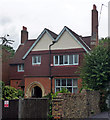1
Pendennis Road
Image: © Lauren
Taken: 2 Mar 2017
0.05 miles
2
5 Pendennis Road
A rare incursion into Streatham of a big name architect, in this case Richard Norman Shaw. Built in 1872-73 for G.H. Best.
Image: © Stephen Richards
Taken: 29 Aug 2015
0.08 miles
3
Astoria Mansions, Streatham High Road
Another block of flats above shops, this one was designed by Messrs Joseph in c1931, and took the original name of the adjacent cinema. It is within the Streatham High Road and Streatham Hill Conservation Area.
The course of Streatham High Road has been a major highway between London and Sussex since Roman times. Its current appearance is largely attributable to two major spells of development. The first was during the late C19th following the opening of Streatham Hill station in 1856, and the second was after 1911 when the line to Victoria was electrified. Though much-maligned and undoubtedly blighted by heavy traffic, closer examination reveals that the road is lined with a number of interesting buildings, some of which reflect the period between the wars when Streatham was a fashionable centre of entertainment. Information from Lambeth Council (http://www.lambeth.gov.uk/NR/exeres/CE4B5CE1-0387-40ED-B5A9-273A5160C34A.htm ).
Typical levels of traffic, approaching the point at which the road narrows.
Image: © Stephen Richards
Taken: Unknown
0.11 miles
4
Odeon Cinema, Streatham High Road
Built as the Astoria (an Odeon since 1961), and opening in 1930, this impressive cinema was the work of Edward Stone, a renowned cinema and theatre architect. It has a swept pantile roof, below which are a series of small windows with their original shutters and 1920s 'Roman-style' metalwork. The original interior, lavishly decorated in an Egyptian style, is apparently still there, but concealed behind more recent (and more prosaic) work. Why not indulge us all and uncover it? Streatham is not exactly spoilt for exotica. The opening of the cinema "rivalled anything in the West End, the 16th Hussars played a fanfare of trumpets and a capacity audience of 2,500 watched the opening performance." It is within the Streatham High Road and Streatham Hill Conservation Area.
The course of Streatham High Road has been a major highway between London and Sussex since Roman times. Its current appearance is largely attributable to two major spells of development. The first was during the late C19th following the opening of Streatham Hill station in 1856, and the second was after 1911 when the line to Victoria was electrified. Though much-maligned and undoubtedly blighted by heavy traffic, closer examination reveals that the road is lined with a number of interesting buildings, some of which reflect the period between the wars when Streatham was a fashionable centre of entertainment. Information from Lambeth Council (http://www.lambeth.gov.uk/NR/exeres/CE4B5CE1-0387-40ED-B5A9-273A5160C34A.htm ).
Image: © Stephen Richards
Taken: Unknown
0.12 miles
5
Elgar House, Streatham High Road
Dating from the 1960s, the work of one William Clark of Pall Mall. A car workshop occupies the ground floor, with offices above and flats in the red-brick section. It is within the Streatham High Road and Streatham Hill Conservation Area, but presumably only because it is on the High Road: the report comments that it is "monotonous" and creates a "deadening break ... breaking the sweep of grand apartment blocks and disrupting the pavement frontage of shops."
The course of Streatham High Road has been a major highway between London and Sussex since Roman times. Its current appearance is largely attributable to two major spells of development. The first was during the late C19th following the opening of Streatham Hill station in 1856, and the second was after 1911 when the line to Victoria was electrified. Though much-maligned and undoubtedly blighted by heavy traffic, closer examination reveals that the road is lined with a number of interesting buildings, some of which reflect the period between the wars when Streatham was a fashionable centre of entertainment. Information from Lambeth Council (http://www.lambeth.gov.uk/NR/exeres/CE4B5CE1-0387-40ED-B5A9-273A5160C34A.htm ).
Image: © Stephen Richards
Taken: Unknown
0.12 miles
6
Streatham High Road, London SW16
Image: © Stacey Harris
Taken: 8 Nov 2008
0.12 miles
7
Odeon Streatham
Image: © Stacey Harris
Taken: 8 Nov 2008
0.13 miles
8
Pinfold Road, London SW16
Image: © Stacey Harris
Taken: 8 Nov 2008
0.13 miles
9
The former British Relay House and later Elgar House, Streatham High Road
This used to be British Relay House, the Southern Area Office of the television rental company British Relay. I worked there on and off between 1965 and 1971 so remember it well as British Relay House when the company occupied the whole building. It later became Elgar House, although any connection with the composer was somewhat remote. The photograph is taken from the middle reservation of the dual carriageway.
By 2014 any mention of Elgar House had gone and instead the sign in its place said "PRS for MUSIC". This is a a UK copyright collection society and performance rights organisation.
Image: © Marathon
Taken: 1 Sep 2010
0.14 miles
10
55-63 Streatham High Road
South of the Odeon, the 1930s architecture of the High Road is replaced by Victorian and Edwardian. This small group of c1900 exhibits many of the characteristics of the rest of the road - Dutch-style shaped gables, patterned stonework, and an oriel at the corner. It is within the Streatham High Road and Streatham Hill Conservation Area.
The course of Streatham High Road has been a major highway between London and Sussex since Roman times. Its current appearance is largely attributable to two major spells of development. The first was during the late C19th following the opening of Streatham Hill station in 1856, and the second was after 1911 when the line to Victoria was electrified. Though much-maligned and undoubtedly blighted by heavy traffic, closer examination reveals that the road is lined with a number of interesting buildings, some of which reflect the period between the wars when Streatham was a fashionable centre of entertainment. Information from Lambeth Council (http://www.lambeth.gov.uk/NR/exeres/CE4B5CE1-0387-40ED-B5A9-273A5160C34A.htm ).
Image: © Stephen Richards
Taken: Unknown
0.14 miles











